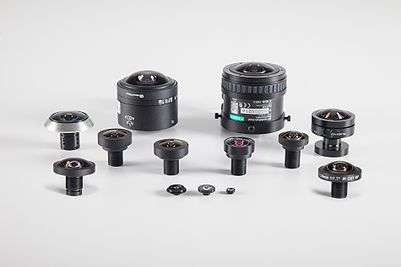Panomorph
The term panomorph derives from the Greek words pan meaning all, horama meaning view, and morph meaning form. A panomorph lens is a particular type of wide-angle lens specifically designed to improve the optical performances in predefined zones of interest or in the whole image compared to traditional fisheye lenses. Some examples of improved optical parameters include the number of pixels, the MTF or the relative illumination.

History
The origin of panomorph technology dates back to 1999 from a French company named ImmerVision [1] now headquartered in Montreal, Canada. Since the first panomorph lenses have been used in video surveillance applications in the early 2000s, panomorph lenses have now become an alternative to other existing wide-angle lenses in a broad range of applications.
Technology
Traditional wide-angle lenses have significant barrel distortion required to image a large field of view on a finite image plane, non-uniform image quality due to the off-axis optical aberrations increasing with the field angle and significant relative illumination falloff due to the cosine fourth illumination law. To improve the optical performances of the resulting images in predefined zones of interest or in the whole image, panomorph lenses can use one or many strategies at the optical design stage, including:
- Using targeted optical distortion that vary across the field of view to vary the magnification and increase the number of pixels in the zone of interest.[2]
- Using optical anamorphosis to create a non-circular image footprint to better match the sensor anamorphic ratio and increase the total number of imaged pixels in the whole image.
- Using optimal balance of various optical parameters (MTF, magnification, relative illumination) considering the image sensor and specific application to equalize the resulting image quality in the whole image.[3]
The zones of interest or whole image improvements resulting from using any of these design strategies in a given panomorph lenses allow providing improved optical performances compared to other traditional wide-angle lenses.[4]
Imaging software
No matter the strategies used to improve the performances in zones of interest, each panomorph lens is designed with specific parameters such as the object-to-image mapping function. Precise knowledge of these design parameters for each panomorph lens is encoded in their unique RPL (Registered Panomorph Lens) code to allow de-warping algorithms to process the image and properly display the final image. The display is optimized to keep advantage of the improved performance in the zone of interest created by the panomorph lenses as opposed to algorithms for fisheye lenses which employ a linear mapping function to de-warp the image without any considerations for their departure from a perfect linear mapping ( distortion).
Applications
By providing wide-angle images with zones of interest, panomorph lenses are often designed with specific applications in mind. Panomorph lenses have already been used in various industries,[5][6] including:
- Broadcast television
- Mobile communications
- Virtual reality cameras
- Action cameras
- Wearable cameras
- Security and surveillance
- Automotive
- Endoscopy
- Aerospace
- Drones
References
- "About ImmerVision, Company Profile".
- Thibault, Simon (2005). "Enhanced optical design by distortion control". Proc. SPIE. 5962. doi:10.1117/12.781598.
- Thibault, Simon (2014). Figueiro, Mariana; Lerner, Scott; Muschaweck, Julius; Rogers, John (eds.). "Design, fabrication and test of miniature plastic panomorph lenses with 180° field of view". Proc. SPIE. International Optical Design Conference 2014. 9293: 92931N. Bibcode:2014SPIE.9293E..1NT. doi:10.1117/12.2074334.
- Thibault, Simon (2010). "Panomorph Based Panoramic Vision Sensors, Vision Sensors and Edge Detection". Francisco Gallegos-Funes (Ed.). ISBN 978-953-307-098-8.
- Thibault, Simon (2008). Schelkens, Peter; Ebrahimi, Touradj; Cristóbal, Gabriel; Truchetet, Frédéric (eds.). "Panoramic lens applications revisited". Proc. SPIE. Optical and Digital Image Processing. 7000: 70000L. Bibcode:2008SPIE.7000E..0LT. doi:10.1117/12.781598.
- Thibault, Simon (2014). "Consumer Electronics Optics: How small a lens can be? The case of panomorph lenses". Proc. SPIE. 9192. doi:10.1117/12.2062418.